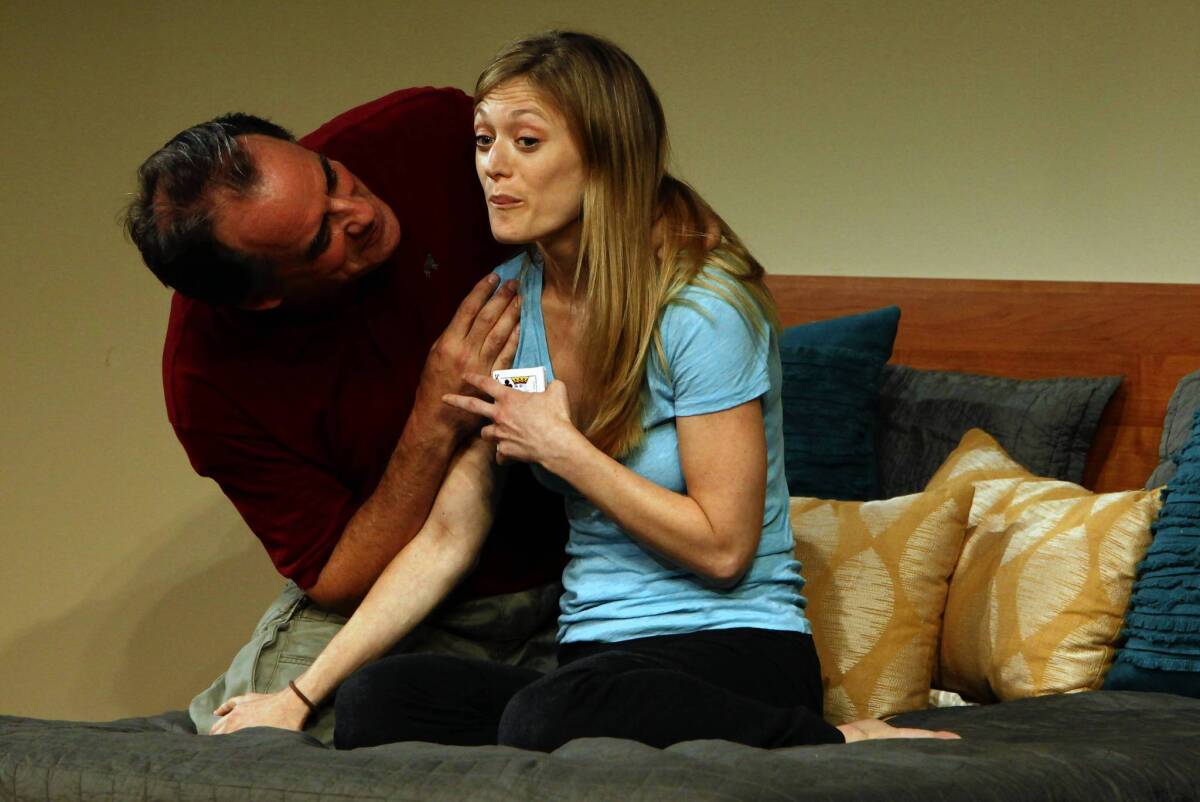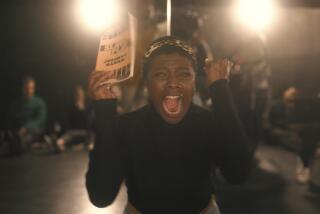Review: ‘A Parallelogram’ as existential riddle

A high-toned concept combined with disagreeable characters and a jaded worldview provided the formula for Bruce Norris’ bracing retort to “A Raisin in the Sun,” “Clybourne Park,” the Pulitzer Prize-winning drama that became a huge hit at the Mark Taper Forum before heading to Broadway and winning the Tony.
The recipe is largely the same for “A Parallelogram,” a slick addition to Norris’ dyspeptic body of work. Unfortunately, the play, now at the Taper, is less revelatory, an existential riddle that’s ultimately more vexing than enlightening.
One shouldn’t expect solace from a writer as aggressively confrontational as Norris, as anyone who saw “The Pain and the Itch” at the Theatre @ Boston Court a few seasons back can attest. One should expect to have one’s face rubbed in the worst aspects of humanity — the selfishness and greed, the vain morality and indifference to other people’s suffering.
PHOTOS: Arts and culture in pictures by The Times
But cynicism must be earned. Here it floats from the playwright’s pen as a toxic plume, enveloping the characters rather than emanating naturally from their disappointed hearts and embittered minds.
The production is confidently staged by Tony winner Anna D. Shapiro, who directed the world premiere of “A Parallelogram” at Chicago’s Steppenwolf Theatre Company in 2010. The Taper’s stage seems a bit too sprawling for the work — the Kirk Douglas Theatre would have been a more fitting venue — but the crackle of the acting and the legerdemain of Todd Rosenthal’s scenic design (transforming from bedroom to hospital room and back again) hijack our attention.
Audiences will likely be reeled in by the fantasy gimmick. Bee (Marin Ireland), a woman in her 30s now living with an older guy, Jay (Tom Irwin), who has left his wife and kids for her, is having a mysterious encounter with what may be her older self. Variously known as Bee 2, Bee 3 and Bee 4, this scathingly honest little old lady (played, in different guises, by that singular comic imp Marylouise Burke) has a magical remote control that allows time to be rewound.
This battery-operated device leads the way to the play’s fundamental philosophical question, posed rather baldly early on by Bee: “If you knew in advance exactly what was going to happen in your life, and how everything was going to turn out, and if you knew you couldn’t do anything to change it, would you still want to go on with your life?”
PHOTOS: Hollywood stars on stage
A compelling subject for dramatic consideration (Sophocles gave it a crack a couple of millenniums ago), but the idea proves in Norris’ hands to be more provocative in theory than in practice. Not that he doesn’t wring some entertaining exchanges from the setup. Irwin and Burke were both in the original Chicago production, and they excel in giving voice to the furious exasperation (Irwin) and sneaky sarcasm (Burke) that are the playwright’s stock in trade. And Ireland holds her irascible own on stage with them.
The problem is that the relationships of the characters aren’t all that convincing or involving. In truth, these individuals, as prickly as they are remote, often seem to be randomly thrown together, like the passengers of an airline disaster movie.
Despite Bee’s attempts to put her relationship with Jay on a smoother course, there’s a peculiar lack of intimacy between them. Norris is no doubt making a point about the eternal strangeness of those closest to us, but he doesn’t engage our interest sufficiently in what’s personally at stake for the couple. How can we care about the far-reaching consequences of a spat between them when their fate is treated as abstractly as a geometric problem?
As for Bee and Bee 2, they’re far too antagonistic to be allies. Bee doesn’t like the idea of one day turning into an old lady in a purple track suit who smokes and watches TV all day, and Bee 2 has no patience with Bee’s illusions of a happy future.
CRITICS’ PICKS: The best art and classical music in town
Bee 2 blithely tells Bee about a viral epidemic that will wipe out much of the world’s population but won’t claim her life. She speaks of this calamity as though it were on balance not such a bad thing. As she sees it, there’s more food to go around, more housing and you never have to wait for a parking space.
“And it’s quiet,” she adds. “That’s the best part — I mean you just never noticed how noisy and stinky and crowded the world had become….”
Hearing the diminutive Burke utter these baleful sentiments in a voice of raspy innocence is a hoot, but they seem to belong more to the playwright than the character. Unless, that is, you accept the proposition that time demoralizes us and that the more we experience life, the less capacity we have to feel it. If this is the case, then Norris is your playwright.
Of course there is the possibility that the curiously unsympathetic Bee 2 doesn’t exist at all, that she’s merely a symptom of a medical or psychological disorder. After all, neither Jay nor JJ, a good-natured gardener forced to wait around for his pay who’s played with a welcome note of gentleness by Carlo Albán, hasn’t a clue that she’s in the room.
Norris keeps us guessing about Bee’s condition, but Bee 2 is incontestably real from beginning to end. In fact, when Burke halts the action to speak directly to the audience, Bee 2 seems more genuine than anything else in the play, except for Irwin when he’s navigating his way through one of his character’s tumultuous what-have-I-done-to-deserve-this monologues.
Although I used to secretly dream in high school of being a geometry teacher, I can’t say that I found Norris’ use of a parallelogram as a way of explaining the crisscrossing nature of time lines to be especially resonant. Like the play as a whole, the talk is more intellectually tantalizing than dramatically meaningful. “A Parallelogram” has the distinction of making us think, but the fruits of this contemplation weren’t for me all that bountiful.
More to Read
The biggest entertainment stories
Get our big stories about Hollywood, film, television, music, arts, culture and more right in your inbox as soon as they publish.
You may occasionally receive promotional content from the Los Angeles Times.











